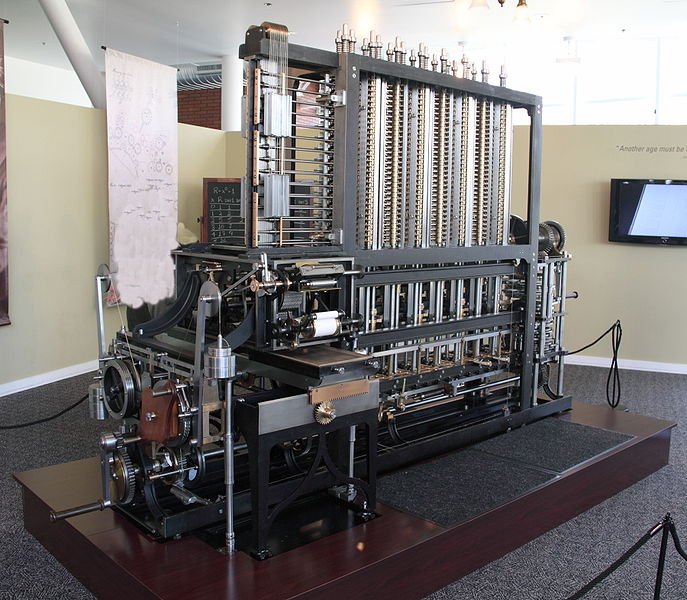
Augusta Ada Byron (known as Ada) was a unique individual in a unique position. While she's sometimes credited as being the first programmer, she wasn't. However, she was present at the birth of computers and offered prophetic insights into their uses.
The daughter of George Gordon, Lord Byron (the Romantic poet) and Anne Milbanke, Ada was born on December 10, 1815, just a month before her parents separated. In fact, she never met her famous father, who left England permanently in 1816. He would die of illness in 1824, while fighting for Greek independence from Turkey.
[As an aside, Byron spent that summer in Geneva with fellow poet Percy Bysshe Shelley and Shelley's future wife, Mary Wollstonecraft. However, due to the massive 1815 eruption of the Indonesian volcano Tambora (the largest eruption of modern times), the weather was mostly dismal. In fact, 1816 was generally known as the "year without a summer" (snow was still falling in New York State in July). To pass the time indoors, they told every ghost story they knew. But they were disappointed in these tales, believed they could do better, and decided to have a contest to see who could write the best one. Only Mary actually finished; you may have heard of her ghost story: "Frankenstein".]
Ada Byron was raised by her mother, and her upper-class life was an amalgam of emotion, reason, poetry, music, and mathematics. Lady Byron wanted her daughter to be as unlike her father as possible, and made sure that Ada was tutored extensively in mathematics. At age 12, she used her considerable mathematical skills to design a flying machine.
Lady Byron and Ada were part of elite London society, whose men followed only a few paths: politics, religion, and the military. The only other respectable profession for a dilettante was "natural science" (zoology, botany, geology, astronomy, and the brand new science of paleontology). There weren't any professional scientists at this time (the word itself only came into existence in 1836), and like so many other fields, science was male-dominated. The participation of noblewomen in intellectual pursuits was neither forbidden nor encouraged.

At a dinner party in 1833, Ada met Charles Babbage, a highly-respected professor of mathematics. She was fascinated with both the man and his designs for computing "Engines". Mostly forgotten today, Babbage was crucial to the scientific and technical development of his age. For his part, Babbage was impressed by Ada's intelligence and enthusiasm.
Among his other achievements, Babbage designed Calculating Engines of two kinds: the table-making Difference Engine and the general purpose calculator he called the Analytical Engine. His design features included storage, internal registers, peripherals, and array processing. None of these Engines was actually built, leading to two questions: would they have worked? and could they have even been built in his lifetime? The answer to the first question is "definitely"; the second, "probably".
In 1834, Babbage designed the Analytical Engine, although his Difference Engine still hadn't been built (the man employed to construct it kept the project going for years without completing it; he and Babbage finally had a falling out over the time and money involved). Parliament refused to support a second machine with the first unfinished, but Babbage managed to stir up some interest abroad.

Difference Engine - finally constructed from Babbage's plans, in 1991, by the London Science Museum
Photo by Allan J. Cronin
Ada subsequently wrote to Babbage expressing her interest in working with him on the Analytical Engine. It was designed to employ punched cards (as used in the Jacquard looms of the day) and she realized that these cards could be re-used to access and compute data.
In 1842, Luigi Menebrea, an Italian mathematician and ambassador to France (who had heard Babbage address a conference in Turin), wrote a paper describing the function and theory of the Analytical Engine. Babbage enlisted Ada (now married to the Earl of Lovelace, and a mother of three) to translate the paper from French into English. This she did, over a nine-month period in 1842-43.
As the translation was proceeding, Babbage agreed to Ada's request to add "notes" to the text, under his supervision. These notes (40 pages of essays) became an invaluable set of instructions for the Engine's operation. More important, the notes included Babbage's views on the Engine's powers and Ada's own speculations on the potential of such a machine.
In the notes, Ada showed how to use the Analytical Engine to compute Bernoulli numbers. For this reason, she has earned the reputation of being the "first computer programmer", although Babbage and others, including his assistant and his sons, had previously written "programs" for the never-completed machine.
For the most part, Ada only reworked calculations that Babbage had carried out years earlier. However, she was Babbage's "interpreter", a remarkable achievement in itself. Ada styled herself "an Analyst (& Metaphysician)"; she understood Babbage's plans as well as he, and was better at expressing them. She wrote that the Analytical Engine was suited for "developping [sic] and tabulating any function whatever...." It might therefore be more accurate to call Ada the "First Computer Technical Writer" (although she was handicapped because the Spell Checker hadn't yet been invented).
Ada's work was carried out during a period when women were generally considered unfit to do research. On the other hand, she was financially well-off, so she had the time and the resources to devote to the Analytical Engine. Also, as a member of the elite class, she had easy entry into scientific and intellectual circles.
Unfortunately, Ada was plagued by asthma and was probably a manic-depressive. An obsessive gambler in her later years, she placed her family under great financial strain. Ada, Lady Lovelace, died of uterine cancer in 1852, when she was 36 (the same age as her never-known father). In 1979, the Department Of Defense honored her by naming a programming language ADA.